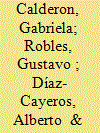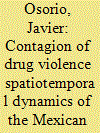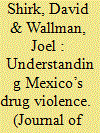|
|
|
Sort Order |
|
|
|
Items / Page
|
|
|
|
|
|
|
| Srl | Item |
| 1 |
ID:
142492


|
|
|
|
|
| Summary/Abstract |
In 2006, the Mexican government launched an aggressive campaign to weaken drug-trafficking organizations (DTOs). The security policies differed significantly from those of previous administrations in the use of a leadership strategy (the targeting for arrest of the highest levels or core leadership of criminal networks). While these strategies can play an important role in disrupting the targeted criminal organization, they can also have unintended consequences, increasing inter-cartel and intra-cartel fighting and fragmenting criminal organizations. What impact do captures of senior drug cartel members have on the dynamics of drug-related violence? Does it matter if governments target drug kingpins versus lower-ranked lieutenants? We analyze whether the captures or killings of kingpins and lieutenants have increased drug-related violence and whether the violence spills over spatially. To estimate effects that are credibly causal, we use different empirical strategies that combine difference-in-differences and synthetic control group methods. We find evidence that captures or killings of drug cartel leaders have exacerbating effects not only on DTO-related violence but also on homicides that affect the general population. Captures or killings of lieutenants, for their part, only seem to exacerbate violence in “strategic places” or municipalities located in the transportation network. While most of the effects on DTO-related violence are found in the first six months after a leader’s removal, effects on homicides affecting the rest of the population are more enduring, suggesting different mechanisms through which leadership neutralizations breed violence.
|
|
|
|
|
|
|
|
|
|
|
|
|
|
|
|
| 2 |
ID:
142490


|
|
|
|
|
| Summary/Abstract |
Why are some territories ravaged by intense levels of criminal violence while others are relatively peaceful? This research contributes to an understanding of the escalation and diffusion of drug violence in Mexico from 2000 to 2010 by formalizing the interactions between the state and organized criminals and by relying on a large database of event data containing more than 1.6 million observations. Results based on spatial econometrics provide evidence of the spatial diffusion of violence. In congruence with the theoretical expectations, the results show that the disruptive effect of law enforcement is an important catalyst for the intensification of violence between criminal organizations, especially when deployed in areas hosting a high concentration of criminal groups. This relationship holds for a broad menu of violent and nonviolent law enforcement tactics. The analysis also reveals that other broadly held factors (international, geographic, and socioeconomic characteristics) have a modest effect on the dynamics of drug-related violence.
|
|
|
|
|
|
|
|
|
|
|
|
|
|
|
|
| 3 |
ID:
142494


|
|
|
|
|
| Summary/Abstract |
Large-scale organized crime occupies a gray zone between ordinary crime and political violence. The unprecedented scale of drug-related crime in Mexico has led to its description as an insurgency or even a civil war, a conceptual move that draws on recent studies that have associated civil war with large-scale criminality. By questioning both the “crime as civil war” and “civil war as crime” models, I argue that instead of folding the two phenomena, we should draw primarily from the micro-dynamics of civil war research program to identify areas of potentially productive cross-fertilization. I point to four such areas, namely, onset and termination, organization, combat and violence, and governance and territory. I conclude by sketching a theoretical and empirical agenda for the study of large-scale organized crime.
|
|
|
|
|
|
|
|
|
|
|
|
|
|
|
|
| 4 |
ID:
142491


|
|
|
|
|
| Summary/Abstract |
This article provides empirical evidence showing that when a multilevel government is well coordinated, organized crime can be more effectively controlled. Using a time-variant data set of Mexico’s cocaine markets at the subnational level and Cox proportional-hazards regressions, I show that when Mexico’s democratization decreased the probability of government coordination—the same party governing a municipality at every level of government—drug traffickers were more likely to violate the long-standing informal prohibition on selling cocaine within the country. It was this decrease in government coordination that would set the conditions for a violent war between drug cartels to erupt in the mid-2000s.
|
|
|
|
|
|
|
|
|
|
|
|
|
|
|
|
| 5 |
ID:
142493


|
|
|
|
|
| Summary/Abstract |
What kind of war is Mexico’s drug war? The prominent “criminal insurgency” approach helpfully focuses attention on cartel–state conflict, but unnecessarily redefines insurgency as “state-weakening,” eliding critical differences in rebels’ and cartels’ aims. Whereas rebels fight states, and cartels fight with one another, to conquer mutually prized territory and resources, cartels fight states “merely” to constrain their behavior and influence policy outcomes. This distinction yields a typology with theoretical consequences: decisive victory plays an important role in most models of civil war but is impossible or undesirable in wars of constraint. Theories of criminal war must therefore explain how ongoing coercive violence can be preferable to pacific strategies. I distinguish two such coercive logics of cartel–state conflict: violent lobbying and violent corruption. Lobbyings' more universalistic benefits elicit free riding, so turf war among cartels should make it rarer than violent corruption. This prediction accords with qualitative and quantitative evidence from Mexico, Colombia, and Brazil.
|
|
|
|
|
|
|
|
|
|
|
|
|
|
|
|
| 6 |
ID:
142489


|
|
|
|
|
| Summary/Abstract |
Violence is commonly viewed as an inherent attribute of the drug trade. Yet, there is dramatic variation in drug violence within countries afflicted by drug trafficking. This article advances a novel framework that explains how the interaction between two critical variables, the cohesion of the state security apparatus, and the competition in the illegal market determines traffickers’ incentives to employ violence. The analysis introduces a generally overlooked dimension of violence, its visibility. Visibility refers to whether traffickers publicly expose their use of violence or claim responsibility for their attacks. Drawing on fieldwork in five cities in Colombia and Mexico (Cali, Medellin, Ciudad Juárez, Culiacán, and Tijuana), 175 interviews, and a new data set on drug violence, I argue that violence becomes visible and frequent when trafficking organizations compete and the state security apparatus is fragmented. By contrast, violence becomes less visible and less frequent when the criminal market is monopolized and the state security apparatus is cohesive.
|
|
|
|
|
|
|
|
|
|
|
|
|
|
|
|
| 7 |
ID:
142488


|
|
|
|
|
| Summary/Abstract |
A dramatic increase in criminal violence in Mexico since 2007 has resulted in an estimated 60,000–70,000 “additional” homicides, often of an especially brutal form, related to drug trafficking and other organized-crime activities. This violence has been accompanied by a steep increase in rates of kidnapping and extortion and has targeted participants in the narcotics trade as well as government officials, journalists, and civil society activists. Despite the magnitude of the violence and enormous public concern about it, scholarly literature on this topic has been scant. This issue offers some of the most promising analyses conducted thus far on the trends in violence and their causes, focusing largely, though not exclusively, on the role Mexico’s government has played in the business of illegal drugs and the violence that accompanies it. In this introduction, we discuss the challenge of deriving reliable statistics on drug-related violence, its spatial and temporal patterns, prevailing explanations, its relationship to organized crime in general, and differences between this violence and substate political violence.
|
|
|
|
|
|
|
|
|
|
|
|
|
|
|
|
|
|
|
|
|